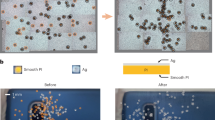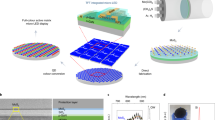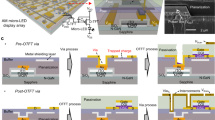Abstract
Microscale light-emitting diodes (LEDs) could be used as the backlights of next-generation displays. However, high-density, large-area displays have stringent requirements in terms of manufacturing yields and the lack of effective tools—capable of high-throughput electroluminescence detection, which can facilitate known-good-die transfer printing—limits mass production of microscale LEDs. Here we show that a three-dimensional flexible probe head (analogous to the rigid probe cards used to conduct wafer-level tests of chips in semiconducting testing) and a corresponding electroluminescence detection system can measure the electrical and optical properties of microscale LEDs without introducing surface defects. Elastic microposts in the probe head can deform adaptively to match the surface morphology of the microscale LEDs and can tolerate height differences between the LED pads. The probe head has 32 × 32 pairs of probes that can simultaneously measure 1,024 microscale LEDs using a passive-matrix driving approach in 0.5 s. The contact stress applied from the probe head to the microscale LEDs is 0.91 MPa, which is at least two orders of magnitude lower than the yield stress that will typically create surface defects. We show that the system can perform more than 1 million repeated contact measurements with negligible probe wear.
This is a preview of subscription content, access via your institution
Access options
Access Nature and 54 other Nature Portfolio journals
Get Nature+, our best-value online-access subscription
27,99 € / 30 days
cancel any time
Subscribe to this journal
Receive 12 digital issues and online access to articles
118,99 € per year
only 9,92 € per issue
Buy this article
- Purchase on SpringerLink
- Instant access to full article PDF
Prices may be subject to local taxes which are calculated during checkout





Similar content being viewed by others
Data availability
Data that support the findings of this study are available from the corresponding author upon reasonable request. Source data are provided with this paper.
Code availability
The codes used in this study are available at https://github.com/imcort/3D-FPH.
References
Ryu, J. E. et al. Technological breakthroughs in chip fabrication, transfer, and color conversion for high-performance micro-LED displays. Adv. Mater. 35, e2204947 (2023).
Chen, D. et al. Integration technology of micro-LED for next-generation display. Research 6, 0047 (2023).
Behrman, K. & Kymissis, I. Micro light-emitting diodes. Nat. Electron. 5, 564–573 (2022).
Yulianto, N. et al. Wafer-scale transfer route for top-down III-nitride nanowire LED arrays based on the femtosecond laser lift-off technique. Microsyst. Nanoeng. 7, 32 (2021).
Li, L. et al. Transfer-printed, tandem microscale light-emitting diodes for full-color displays. Proc. Natl Acad. Sci. USA 118, e2023436118 (2021).
Park, S. I. et al. Printed assemblies of inorganic light-emitting diodes for deformable and semitransparent displays. Science 325, 977–981 (2009).
Cok, R. S. et al. Inorganic light-emitting diode displays using micro-transfer printing. J. Soc. Inf. Disp. 25, 589–609 (2017).
Zhu, S. et al. Characteristics of GaN-on-Si green micro-LED for wide color gamut display and high-speed visible light communication. ACS Photonics 10, 92–100 (2022).
Pan, Z. et al. Wafer-scale micro-LEDs transferred onto an adhesive film for planar and flexible displays. Adv. Mater. Technol. 5, 2000549 (2020).
Lee, H. E. et al. Wireless powered wearable micro light-emitting diodes. Nano Energy 55, 454–462 (2019).
Xia, Y. et al. A 4-channel optogenetic stimulation, 16-channel recording neuromodulation system with real-time micro-LED detection function. Electronics 12, 4783 (2023).
Ohta, Y. et al. Micro-LED array-based photo-stimulation devices for optogenetics in rat and macaque monkey brains. IEEE Access 9, 127937–127949 (2021).
Shang, X. et al. Construction of a flexible optogenetic device for multisite and multiregional optical stimulation through flexible µ‐LED displays on the cerebral cortex. Small 19, e2302241 (2023).
Reddy, J. W. et al. High density, double-sided, flexible optoelectronic neural probes with embedded μLEDs. Front Neurosci. 13, 745 (2019).
Lee, H. E. et al. Micro light‐emitting diodes for display and flexible biomedical applications. Adv. Funct. Mater. 29, 1808075 (2019).
Akhil, N. Micro-LED Display Market Size, Share and Forecast to 2031 (Straits Research, 2022).
Huang, Y. et al. Prospects and challenges of mini-LED and micro-LED displays. J. Soc. Inf. Disp. 27, 387–401 (2019).
Chen, Z., Yan, S. & Danesh, C. MicroLED technologies and applications: characteristics, fabrication, progress, and challenges. J. Phys. D: Appl. Phys. 54, 123001 (2021).
Asad, M. et al. Thermal and optical properties of high-density GaN micro-LED arrays on flexible substrates. Nano Energy 73, 104724 (2020).
Chen, M. et al. Defect detection of MicroLED with low distinction based on deep learning. Opt. Lasers Eng. 173, 107924 (2024).
Wang, L. & Ma, S. Probe card lifetime control and abrasion coefficient study. In Proc. 2020 China Semiconductor Technology International Conference 1–3 (IEEE, 2020).
Chien, C.-F. & Peng, J.-Y. Bayesian inference for multi-label classification for root cause analysis and probe card maintenance decision support and an empirical study. J. Intell. Manuf. 36, 1943–1958 (2024).
Chien, C.-F. & Wu, H.-J. Integrated circuit probe card troubleshooting based on rough set theory for advanced quality control and an empirical study. J. Intell. Manuf. 35, 275–287 (2022).
Yuan, T. et al. Design, fabrication and characterization of MEMS probe card for fine pitch IC testing. Sens. Actuators, A 204, 67–73 (2013).
Chiang, C. H. et al. Development of a neural interface for high-definition, long-term recording in rodents and nonhuman primates. Sci. Transl. Med. 12, eaay4682 (2020).
Huang, X. et al. Epidermal impedance sensing sheets for precision hydration assessment and spatial mapping. IEEE Trans. Biomed. Eng. 60, 2848–2857 (2013).
Huang, Y. et al. A skin-integrated multimodal haptic interface for immersive tactile feedback. Nat. Electron. 6, 1020–1031 (2023).
Yu, X. et al. Skin-integrated wireless haptic interfaces for virtual and augmented reality. Nature 575, 473–479 (2019).
Zhou, D. et al. Key technologies of high-end SOC probe card. In Proc. 2022 23rd International Conference on Electronic Packaging Technology 1–4 (IEEE, 2022).
Marinov, V. R. 52‐4: laser‐enabled extremely‐high rate technology for µLED assembly. SID Symp. Dig. Tech. Pap. 49, 692–695 (2018).
Zhang, B. & Haupt, O. 55.4: MicroLED ‐ high throughput laser based mass transfer technology. SID Symp. Dig. Tech. Pap. 52, 664–667 (2021).
Eo, Y. J. et al. Enhanced DC-operated electroluminescence of forwardly aligned p/MQW/n InGaN nanorod LEDs via DC offset-AC dielectrophoresis. ACS Appl. Mater. Interfaces 9, 37912–37920 (2017).
Hwang, J. et al. Wafer-scale alignment and integration of micro-light-emitting diodes using engineered van der Waals forces. Nat. Electron. 6, 216–224 (2023).
Chang, W. et al. Concurrent self-assembly of RGB microLEDs for next-generation displays. Nature 617, 287–291 (2023).
Lee, D. et al. Fluidic self-assembly for MicroLED displays by controlled viscosity. Nature 619, 755–760 (2023).
Kim, S. et al. Enhanced adhesion with pedestal-shaped elastomeric stamps for transfer printing. Appl. Phys. Lett. 100, 171909 (2012).
Park, S. H. et al. Universal selective transfer printing via micro-vacuum force. Nat. Commun. 14, 7744 (2023).
Huang, C. Y. et al. MQWs InGaN/GaN LED with embedded micro-mirror array in the epitaxial-lateral-overgrowth gallium nitride for light extraction enhancement. Opt. Express 18, 10674–10684 (2010).
Andreas, B. et al. Method of transferring a micro device. US patent US8333860B1 (2014).
McQueen, R. G. & Marsh, S. P. Ultimate yield strength of copper. J. Appl. Phys. 33, 654–665 (1962).
Greer, J. R. & Nix, W. D. Size dependence of mechanical properties of gold at the sub-micron scale. Appl. Phys. A 80, 1625–1629 (2005).
Madsen, M. H. et al. Accounting for PDMS shrinkage when replicating structures. J. Micromech. Microeng. 24, 127002 (2014).
Lee, S. W. & Lee, S. S. Shrinkage ratio of PDMS and its alignment method for the wafer level process. Microsyst. Technol. 14, 205–208 (2007).
Tang, K.-H., Lee, Y.-H. & Wu, T.-H. The development of luminance uniformity measurement for CNT-BLU based on human visual perception. J. Chin. Inst. Ind. Eng. 28, 179–191 (2011).
Zhao, P. et al. Perceptual spatial uniformity assessment of projection displays with a calibrated camera. In Proc. Color and Imaging Conference 159–164 (Society for Imaging Science and Technology, 2014).
Kim, K. et al. High-precision color uniformity based on 4D transformation for micro-LED. In Proc. SPIE XXIV, 113021U (SPIE, 2020).
Multimedia Systems and Equipment. Colour Measurement and Management Part 2-1: Colour management. Default RGB colour space. sRGB. International Standard IEC 61966-2-1:1999 (International Electrotechnical Commission, 1999).
Chen, H. W. et al. Going beyond the limit of an LCD’s color gamut. Light. Sci. Appl. 6, e17043 (2017).
Yu, D. et al. Room-temperature ion-exchange-mediated self-assembly toward formamidinium perovskite nanoplates with finely tunable, ultrapure green emissions for achieving Rec. 2020 displays. Adv. Funct. Mater. 28, 1800248 (2018).
Kumar, S. et al. Ultrapure green light-emitting diodes using two-dimensional formamidinium perovskites: achieving Recommendation 2020 Color Coordinates. Nano Lett. 17, 5277–5284 (2017).
Zhu, R. et al. Realizing Rec. 2020 color gamut with quantum dot displays. Opt. Express 23, 23680–23693 (2015).
Oh, C.-H., Shim, J.-I. & Shin, D.-S. Current- and temperature-dependent efficiency droops in InGaN-based blue and AlGaInP-based red light-emitting diodes. Jpn J. Appl. Phys. 58, SCCC08 (2019).
Acknowledgements
This work is supported by the National Natural Science Foundation of China under grant nos. 52121002 (X.H.) and 62371335 (X.H.). This work is also partially supported by the Tiankai Higher Education Sci-Tech Innovation Park Enterprise R&D Special Program under grant no. 23YFZXYC00031 (X.H.).
Author information
Authors and Affiliations
Contributions
Z.W. and X.Z. contributed equally to this work. Z.W. and X.H. designed the 3D-FPH. Z.W., X.Z., C.J., J.W., Y.Z., R.Z., J.X., W.H., Q.Y. and X.H. fabricated the 3D-FPH. Z.W., C.L. and X.H. designed and developed the measurement system. Z.W. designed and tested the interfacing circuit. Z.W. and X.Z. performed the experiments and simulations. All photographic and diagrammatic content in the figures was created and composed by Z.W. and X.H. X.H. conceived, designed and directed the project. All authors analysed the data, discussed the results and commented on the paper. X.H. and Z.W. wrote the paper with input from all authors.
Corresponding author
Ethics declarations
Competing interests
The authors declare no competing interests.
Peer review
Peer review information
Nature Electronics thanks Ziquan Guo and the other, anonymous, reviewer(s) for their contribution to the peer review of this work.
Additional information
Publisher’s note Springer Nature remains neutral with regard to jurisdictional claims in published maps and institutional affiliations.
Supplementary information
Supplementary Information
Supplementary Notes 1 and 2, Tables 1–3 and Figs. 1–34.
Supplementary Video 1
A microscale LED wafer measurement process using the 3D-FPH and the associated system.
Source data
Source Data Fig. 1
Statistical source data.
Source Data Fig. 2
Statistical source data.
Source Data Fig. 3
Statistical source data.
Source Data Fig. 4
Statistical source data.
Rights and permissions
Springer Nature or its licensor (e.g. a society or other partner) holds exclusive rights to this article under a publishing agreement with the author(s) or other rightsholder(s); author self-archiving of the accepted manuscript version of this article is solely governed by the terms of such publishing agreement and applicable law.
About this article
Cite this article
Wu, Z., Zhang, X., Jiang, C. et al. Electroluminescence measurement of microscale light-emitting diode wafers using a three-dimensional flexible probe head. Nat Electron 8, 496–509 (2025). https://doi.org/10.1038/s41928-025-01396-0
Received:
Accepted:
Published:
Issue Date:
DOI: https://doi.org/10.1038/s41928-025-01396-0
This article is cited by
-
Testing microscale light-emitting diodes with a lighter touch
Nature Electronics (2025)



